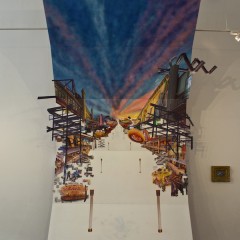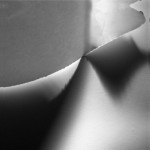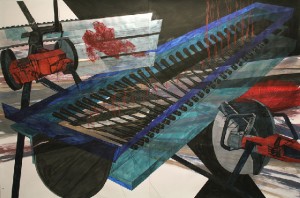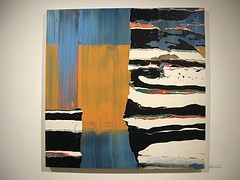In Jon Manteau’s third solo exhibition at LGTripp Gallery, To a Hammer, Everything Looks Like a Nail, on view through May 6, the artist explores mark-making using unconventional application techniques. In the front window, a video shows the artist creating the exhibition’s largest work, “Gumtrees and Ghosts.” Through this video, the artist’s work process is revealed.
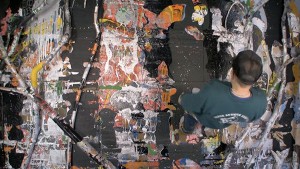
Manteau begins by priming eight panels of plywood that lay before him on the ground. The panels never stand upright until they are hung for display at the video’s conclusion. Instead, like the Action painters before him, Manteau paints from above, exerting his physical presence.
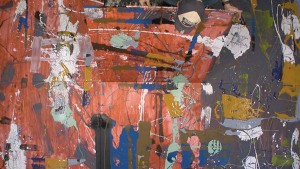
As the title of the exhibition suggests, the artist does not limit his tools to traditionally accepted instruments. Instead, he opts for brooms and mops to push paint across the sheets of plywood. Pouring house paint directly from the can as he tilts each panel, Manteau welcomes the act of spontaneous mark-making. He drips paint on large sponges that act as stamps, flipping them over and walking across them to leave an impression. Other household items like rags are used to selectively wipe paint off the surface. Manteau also places pieces of silver-painted driftwood on top of the panels. These sculptural elements are then painted with additional layers of colorful paint and hung in front of the panels, both in the video and upon entering the gallery.
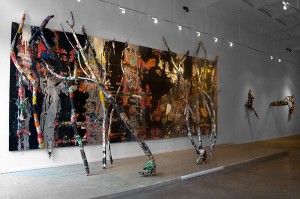
“Gumtrees and Ghosts” measures eight feet by twenty feet and was produced specifically for the exhibition. Through its massive scale and combination of both painting and sculpture, “Gumtrees and Ghosts” is the artist’s most ambitious piece. It serves as a prime example of his artistic process and consideration of materials.
The work’s driftwood elements are painted in the same palette as the plywood behind and vacillate between figure and ground. The inclusion of these protruding, natural elements suggests a physical space to inhabit, while the frenetic energy of the artist’s mark-making suggests chaos and flux. By covering the pieces of driftwood in paint, their organic character is diminished. Instead, the sculptural elements take on a synthetic appearance. Together with the painting’s saturated color palette and blotches of black paint, this loss of organic character suggests the ephemerality of nature. While painting the pieces of driftwood hides their natural surface, it also acts as a protective barrier against the elements. Manteau’s attempt to preserve the discarded points to its inevitable deterioration.
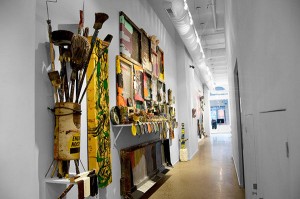
Jon Manteau’s interest in remnants and transitory objects is also evident in “Studio Recreation.” The assemblage is comprised of a diverse range of tools, many of which are seen in the previously mentioned video. Small flecks of dried paint are stored in jars that sit on a shelf that resembles a fireplace mantle. Paint trays are hung above this mantle as if they themselves are valued works deserving a place of honor. By collecting and displaying the residual, Manteau expresses his interest in the traces that human beings leave behind.


